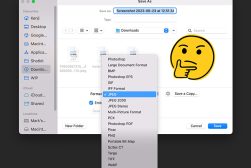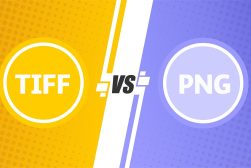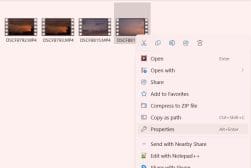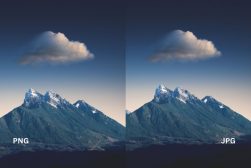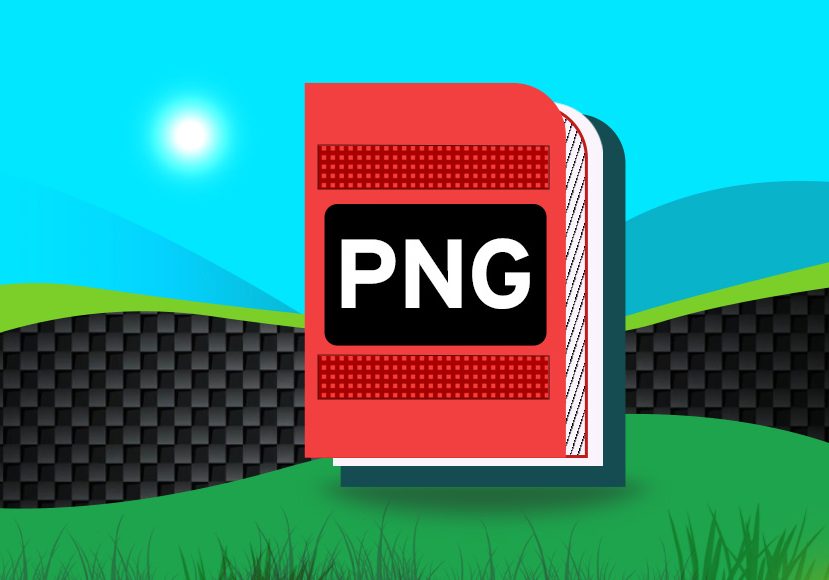
What Are PNG Files? (+ Why/How Should You Use PNGs?)
Dive into the world of PNG files, exploring their unique features and uncovering the best scenarios for their optimal use in photography and graphic design.
Image File Formats | Learn | By Jeff Collier
What is a PNG file? And when should you use one?
PNG is one of the most common image image file formats out there, so it helps to gain an understanding of what it’s all about.
This guide will take you through what PNG means, what PNG files are used for, the pros and cons of the PNG format, and more.
We’ll also explain how to open a PNG file, plus how to edit and convert them using various methods.
You’ll be a PNG expert in no time. So, let’s get started!
What Is A PNG File?
Ever wondered about those images with the “.png” file extension at the end?
Well, PNG stands for Portable Network Graphics. It’s a type of image file format that’s known for being great at keeping all the details through something called “lossless compression.”
PNG files are simply images that have been saved in this specific way.
Unlike some other image types, a PNG image doesn’t lose its sharpness or detail, no matter how many times you save or edit it.
Brief History of PNG Files
The PNG file format was developed in the mid-1990s as a response to the patent issues surrounding the GIF format.
It was officially introduced to the public in 1996.
PNG files were created to give people access to an image format free from legal constraints, offering better compression and more features not available in the GIF format (such as support for a broader range of colors and better transparency handling).
The PNG format quickly gained traction due to its lossless compression capabilities, ensuring that images maintained their original quality.
What are PNG Files Used For?
PNG files have found a broad range of applications across the digital world.
Given their lossless compression, the PNG image format is ideal for images that require frequent editing, as the quality remains intact after multiple saving iterations.
They’re commonly used in web design due to their support for transparent backgrounds, making them perfect for logos, icons, and other graphic elements.
Additionally, the PNG format is popular among photographers and graphic designers for digital art, infographics, and images that necessitate detailed transparency.
Beyond the web, PNG images are also commonly used in software, applications, and mobile apps due to their sharpness and versatility.
PNG-8 vs. PNG-24 vs. PNG-32
Another thing to know about PNG files is that they come in several different formats: 8-bit, 24-bit, and 32-bit.
- PNG-8: The 8-bit PNG file format utilizes a palette of up to 256 colors, making it suitable for simpler images without many color variations.
- PNG-24: Offers truecolor images, supporting up to 16 million colors. It’s excellent for more complex images without requiring palette limitations.
- PNG-32: Essentially the same as the PNG-24 file format with additional alpha channel transparency, allowing for varied transparency levels in the image.
Pros & Cons of PNG Files
The PNG file format has a lot to offer, but like everything, it has its strengths and weaknesses.
How Much Do You REALLY Know About Photography?! 🤔
Test your photography knowledge with this quick quiz!
See how much you really know about photography...

Pros:
- Lossless Compression: PNG files keep all their details intact, no matter how many times they’re edited or saved.
- Transparency Support: They’re ideal for web graphics like logos and icons because they can have clear backgrounds.
- Wide Color Range: The PNG format supports a broad range of colors, which is great for high-quality images.
- No Legal Constraints: Unlike some other formats, PNG was developed to be free from legal issues.
Cons:
- File Size: Because of their high quality, PNG files can be larger than other formats like JPEG.
- Not Ideal for Photos: While PNG is perfect for graphics, it might not always be the best choice for photographs, especially when file size is a concern.
- Slower to Load: Larger file sizes can mean slightly slower load times on websites.
PNG vs JPG vs GIF: When and Why to Use Each
Knowing what PNG files are all about is one thing, but it can still be confusing knowing when to use one image format or another.
Understanding the differences between these common file formats can guide you in selecting the best one for your needs.
PNG (Portable Network Graphics)
- When to use: PNG files are the go-to when you require high-quality transparent graphics or when you’re working with images that will be edited multiple times.
- Why: PNG supports lossless compression, meaning the quality won’t degrade no matter how many times the image is saved or edited. It also excels in maintaining image transparency, making it ideal for logos, icons, and other graphics where a transparent background is beneficial.
JPG (or JPEG, Joint Photographic Experts Group)
- When to use: JPG is best for photographs, especially when you need to balance good quality with a smaller file size.
- Why: JPG uses lossy compression, which reduces file size but can sacrifice some detail and quality. This makes it efficient for storing and sharing photos, especially on the web, where smaller file sizes mean faster loading times. However, unlike with PNG files, each time you edit and save a JPG, some quality is lost.
- Read more: JPG vs PNG: Quality Differences You Should Know
GIF (Graphics Interchange Format)
- When to use: GIF is ideal for simple animations, especially for the web. It’s also suitable for images with limited colors, like logos and icons, but not as widely used for this purpose anymore due to PNG’s capabilities.
- Why: GIF supports animation and can have transparent backgrounds, but the transparency is not as smooth as PNG’s. It only supports a limited color palette of 256 colors, making it less suitable for full-color photos but efficient for animations.
In essence, your choice between GIF, JPG, and PNG files will hinge on your specific requirements – whether that’s image transparency, file size, animation, or the preservation of image quality.
You should also read about TIFF vs PNG.
How to Open PNG Files
Opening a PNG file is straightforward, as most modern image viewers and browsers natively support the PNG format.
If you’re using a computer, you can simply double-click the PNG file, and it should open with the default image viewer.
On mobile devices, tapping on a PNG image will typically open it in the default photo app.
If, for some reason, it doesn’t open, you can choose from a myriad of free and paid image-viewing software available for both PCs and mobile devices.
How to Open a PNG File Online
If you don’t want to download a PNG image but want to view it online, there are several online tools and platforms available.
Websites like “Online Image Viewer” or “ViewPNG” allow users to upload and view PNG files directly from their browsers.
To use these tools:
- Navigate to the online PNG viewer of your choice.
- Upload the PNG file or provide a link if it’s hosted online.
- Wait for the tool to process and display the image.
- View the PNG image directly in your browser without any need for downloads.
These online tools can be especially handy if you’re using a device where you don’t have permission to download files or install new software.
How to Create and Edit PNG Files
Creating and editing PNG files is a process that’s both simple and versatile, thanks to the vast array of graphic software available.
Most graphic design programs, from beginner-friendly ones to professional suites, support the PNG file format. These include popular programs like:
- Adobe Photoshop
- GIMP
- CorelDRAW
- Microsoft Paint
- Paint.NET
- Adobe Illustrator
- Inkscape
When creating a new digital artwork or graphic, simply save or export your project as a PNG file to benefit from its lossless compression, which ensures that your image retains all its quality and detail.
To edit existing PNG images, open the file in your preferred graphic software.
You can easily open PNG files in programs like Adobe Photoshop, GIMP, or even Microsoft Paint. Once open, you can make any desired modifications.
Remember, one of the strengths of the PNG format is its lossless compression. This means that, as you edit and re-save, the image won’t lose its original quality.
How to Convert PNG Files
There might be times when the PNG file format isn’t suitable for your needs, and you need to convert it to another format.
Luckily, converting PNG files is a breeze with the right tools.
Several software applications and online platforms can convert PNG files to other formats like JPEG, BMP, or GIF.
To convert PNG files:
- Choose a conversion tool or software. Many image editors, like Adobe Photoshop or GIMP, have built-in conversion capabilities.
- Open the PNG file in your chosen tool.
- Navigate to the “Save As” or “Export” function.
- Select your desired output format.
- Save the new file.
If you’re in a hurry or don’t have access to image editing software, online conversion tools can be a lifesaver. Simply upload the PNG image, choose your output format, and let the platform do the work.
Remember, though, converting to some formats might not retain the lossless quality of your original PNG, so always double-check the results to ensure they meet your expectations.
Optimizing PNG Compression for Web and Mobile
Understanding how to optimize the compression of PNG files can improve the performance of websites and apps, making them load faster without sacrificing too much on image quality.
- Why Optimize: Large image files can slow down website load times, leading to a poor user experience. Optimizing PNG files can significantly reduce their size, ensuring quick page loads while retaining reasonable image quality.
- Lossless vs. Lossy Compression: While PNG is known for lossless compression (retaining all image data), some tools offer “lossy” compression for PNG files, which sacrifices a bit of quality for a smaller file size. Depending on the use case, especially for web images where slight quality reduction might not be noticeable, lossy compression can be an option.
- Tools for PNG Optimization: Several tools, both online platforms and downloadable software, are designed specifically to optimize PNG files. Common options include TinyPNG, CompressPNG, and OptiPNG. These tools often offer a drag-and-drop interface where you can see the size reduction and quality difference instantly.
- Consider Resolution: Apart from compression, consider the resolution of your PNG images. For web and mobile use, high-resolution images might be unnecessary and can increase file sizes. Resize the image to the actual size needed for display.
- Alpha Channel Transparency: PNG files can have transparent backgrounds, but this “alpha channel” transparency can increase the file size. If you don’t need a smooth gradient of transparency, consider using a simpler transparency option or a palette-based PNG-8 instead of PNG-24.
By taking a few extra steps to optimize your PNG files, you can ensure the right balance between quality and performance, making your digital content more accessible and user-friendly.
PNG File FAQs
What is a PNG file used for?
A PNG file is used for storing images with clear backgrounds, like logos, and for images that need to keep all their quality details when edited or saved multiple times.
Is PNG better than JPEG?
It depends on the need. PNG is great for transparency and lossless quality, while JPEG is more compressed and better for reducing file sizes, especially with photos.
Is PNG OK for photos?
Yes, PNG can be used for photos, especially if you want to keep all the image’s details. However, PNG files might be larger than JPEGs, which can be more efficient for photos.
Is PNG good enough for printing?
PNG is clear and high-quality, so it can be good for printing. However, for professional prints, TIFF or other high-resolution formats might be preferred. Always check the resolution of your PNG before printing.

Check out these 8 essential tools to help you succeed as a professional photographer.
Includes limited-time discounts.





